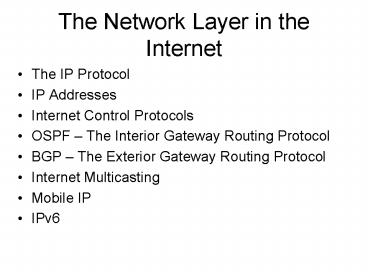The Network Layer in the Internet - PowerPoint PPT Presentation
1 / 18
Title:
The Network Layer in the Internet
Description:
How Subnets are supported in IP addresses ... A set of IP address assignments. ... Every IP address does not uniquely identify a single machine ... – PowerPoint PPT presentation
Number of Views:39
Avg rating:3.0/5.0
Title: The Network Layer in the Internet
1
The Network Layer in the Internet
- The IP Protocol
- IP Addresses
- Internet Control Protocols
- OSPF The Interior Gateway Routing Protocol
- BGP The Exterior Gateway Routing Protocol
- Internet Multicasting
- Mobile IP
- IPv6
2
Design Principles for Internet
- Make sure it works.
- Keep it simple.
- Make clear choices.
- Exploit modularity.
- Expect heterogeneity.
- Avoid static options and parameters.
- Look for a good design it need not be perfect.
- Be strict when sending and tolerant when
receiving. - Think about scalability.
- Consider performance and cost.
3
Collection of Subnetworks
- The Internet is an interconnected collection of
many networks.
4
The IP Protocol
- The IPv4 (Internet Protocol) header.
5
The IP Protocol (2)
- Some of the IP options.
5-54
6
IP Addresses (for interfaces)
- IP address formats.
A 128 networks with 16 million hosts B 16384
networks with 64K hosts C 2 million networks
with 256 hosts
7
How are IP packets processed
- Routing
- table
- Small size compared to keeping all network, host
pairs
8
IP Addresses (2)
- Special IP addresses.
9
Subnets
- - Hard to put all hosts on a single network.
- Soln Split a network into smaller parts
(subnets) for internal use which still acts like
a single network to the outside world - Subnetting is not visible outside the network.
- Remember hierarchical routing.
10
Subnets
Ex A campus network consisting of LANs for
various departments.
11
How Subnets are supported in IP addresses
- Host number in the IP packet is partitioned into
(subnethost)
Ex A class B network subnetted into 64 subnets.
12
How are IP packets processed with subnetting
- A three level hierarchy yields further savings in
routing table memory space
13
CIDR Classless InterDomain Routing
Problem Too few class B networks with larger
than needed address space. Too many class C
networks with inadequate address space. Midway
solution would have half a million networks would
mean large routing tables. (Each network needs
to know how to get to all the others.)
CIDR Allocate IP addresses in variable size
blocks with a block of 2N addresses on a 2N byte
boundary
- A set of IP address assignments.
14
CIDR
Ex Incoming IP packet dest. address
194.24.10.15 IP packet Addr. Edinburg Mask
194.24.8.0 Edinburg base address Ex Incoming IP
packet dest. address 194.24.12.15 When ANDed
with any of the three masks we do not get the
corresponding base addr.
15
CIDR Aggregate routing
Treat the union of the address spaces of the
three networks as one aggregate address space
16
NAT Network Address Translation
- Placement and operation of a NAT box.
17
Network address translation
- Solution to increase address space of networks
- Ranges 10.0.0.0-10.255.255.255/8
- 172.16.0.0-172.31.255.255/12
- 192.168.0.0-192.168.255.255/16
- reserved for internal use inside company/ISP
premises - Int. IP address gt Ext. IP address
- Index(TCP Source port Int. IP address)gtTCP
Source port
18
Problems with NAT
- Every IP address does not uniquely identify a
single machine - NAT changes the network from connectionless to
connection oriented (if NAT box crashes address
mapping lost) - Protocol layers are no longer independent.
- Depends on the use of TCP/UDP.
- Assumes IP addresses are found in the IP address
field. - Limited to less than 65536 internal IP addresses
for each ext. IP address (TCP source port field
is 16 bits) - Transition to IPv6 (128 bit IP addresses) delayed

